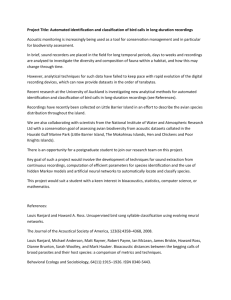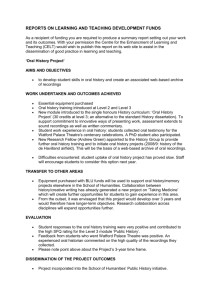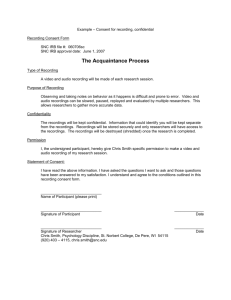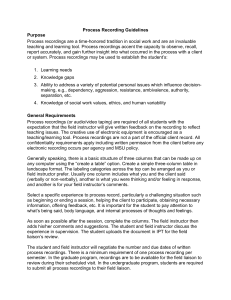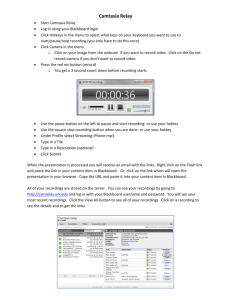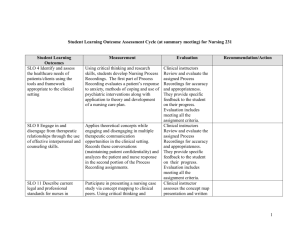The Flipped Classroom - English Teaching Professional
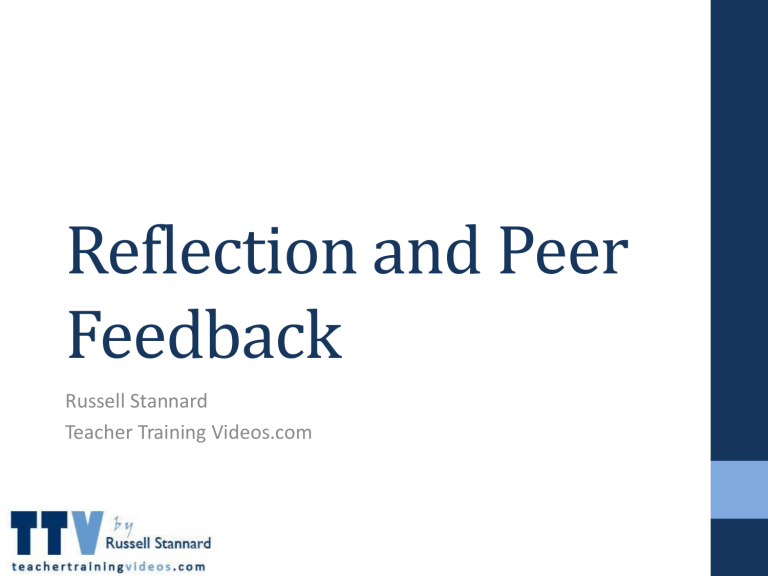
Reflection and Peer
Feedback
Russell Stannard
Teacher Training Videos.com
This presentation
• A quick bit of information about my work
• Two approaches to the issue of feedback/peer feedback
Technology for speaking-feedback
Using technology directly to get students to reflect
• Conclusions
Profile
• NILE associate trainer.
• Part-time lecturer at the University of Warwick.
• Write the ‘Webwatcher’ in the ET Pro.
• Run www.teachertrainingvideos.com.
• Last year 350,000 visitors.
• Provides FREE help videos to show teachers how to use technology.
Oral skills
• My own experience of learning languages.
• Often the reason people want to learn languages.
• A very cognitive process.
• More and more oral exams.
• Requires a lot of time.
• Need scaffolding.
• Hard to measure.
• Meaning-real communication (not repetition).
• Works best when students are familiar with the topic.
Paul Nation
Criteria
• Meaning ( produce a message)
• Easy (100% familiar )
• Learners need to pushed/challenged to go faster
• Reasonable quantities ( technology)
25% of a lesson should be focused on fluency
Peter Schneider/David kluge
Kluge
-Students work in groups and record weekly sessions.
-One tape for making regular recordings.
-One for the first and last recordings the students did.
-Students self evaluated their recordings.
Schneider
-Students had a choice of doing class or doing recordings.
-Class or pair taping.
-Did better in exams with oral taping.
Early Work
• Did a variety of projects where I got students recording themselves.
• Mainly used a tool called Vocaroo.
A quick summary of feedback
• Not all students did the work.
• Inconsistent.
• Not related enough to the class.
• No framework/guide.
• Lack of feedback.
• Not consistent enough.
Forming my ideas
Connect what I do in the class with the recordings I want the students to do at home.
Provide practice/framework/scaffolding
Do examples in the class to make the technologies clear
Provide models
Have a place to store the recordings ( Blogger).
Deal with the problem of feedback through peer evaluation/self reflection
myBrainShark
• Student creates a PP presentation
• Uploads onto myBrainShark
• Adds voice
• Shares (email, e-portfolio)
• Review/feedback
Example
Challenge
How do you deal with 30 recordings regarding feedback
Dealing with the feedback
• Students do recordings in pairs/groups.
• Shift the expectation . Autonomous learning.
• Part of Autonomous Learning is that students need to evaluate their own work.
• Research suggests training the students to provide feedback/peer feedback.
• There are things that students can do/can’t do
Feedback-part 1
Students could evaluate their own recordings look at the 3 areas of –slides/process/recording
• The slides
• How much writing did you have on each slide? Do you think it might distract the listener?
• Have you got consistent title sizes and font sizes?
• Have you used any pictures? Do you have permission to use them?
• Did you read off the slides or talk around them?
• Is the design of all the pages equal?
• Are the font sizes big enough to read?
• The Process
• What did you do to plan your presentation?
• Did you practice before doing the recording
• How many times did you do your recording before sharing it?
• Did you have notes to help you add your voice to the slides?
• Did you write down useful vocabulary or language to help you when making the slides?
• Did you play back your recording before sending it?
Feedback-part 2
• The Recording
• Are there any pauses in your recording?
• Do you talk between slides?
• Do you ever go off point/topic?
• Do you read from the slides rather than talk around them?
• Do you think your voice sounds engaging?
• Do you start with an introduction where you explain what you are going to talk about?
• Do you finish with a set of conclusions?
Icy Lee
• Influenced by the work of Icy Lee
Students worked on process writing activities
Included feedback from peers/self evaluation
Built up a collection of written pieces
Students chose which essay was going to be put forward for formal feedback.
• So
A place to easy access the recordings and leave notes/feedback.
Organised way of giving feedback/peer feedback
Student would choose which recordings they want formally assessed.
Choose from a selection
Peer/Self
Peer/Self
Peer/Self
Dip in
• Recordings are placed in a blog.
• Teacher dips and occasionally leaves feedback.
• Students are paired and provide regular feedback to each other.
• Students also evaluate their own work.
• We have successfully done this with the blogs on our MA in
ICT course (not self-evaluation part)
Using technology for reflection/self evaluation
• We have looked at the idea of using technology for developing students fluency directly.
• Use technology to actually get students reflecting
Example
-I have done a class-I want to get feedback on how they performed in a group work activity.
-Students write essays and provide recorded feedback.
-I want to know their progress on their dissertations.
Example one
Video for All
• http://videoforall.eu/
• Collection of practices of using video in language teaching.
• Organised by different categories.
• Examples of some of the ideas I have suggested today.
• Looks at
-Creating Video-teacher/student making videos
-Use Video-using video for stimulus/input
-Communicating with video-using video to communicate information.
Video for All
Conclusions
• Technology can be used to encourage students to do oral work.
• We don’t’ have to always provide the feedback on their recordings. The students can also do this.
• They can build up e-Portfolios with all their recordings.
• Students can evaluate/peer evaluate and then choose from a selection of recordings what they want formally evaluated.
• A second idea is to get the students to do oral recordings for feedback.
References
• Paul Nation on Fluency https://www.youtube.com/watch?v=-
RgcY3Ka97Y&feature=youtu.be
• David Kluge http://iteslj.org/Techniques/Kluge-PartnerTaping.html
• Peter Schneider http://iteslj.org/Techniques/Schneider-PairTaping.html
• ICY Lee /Ricky Lam (2010)/ Balancing the dual functions of portfolio assessment. ELT J 64/1
